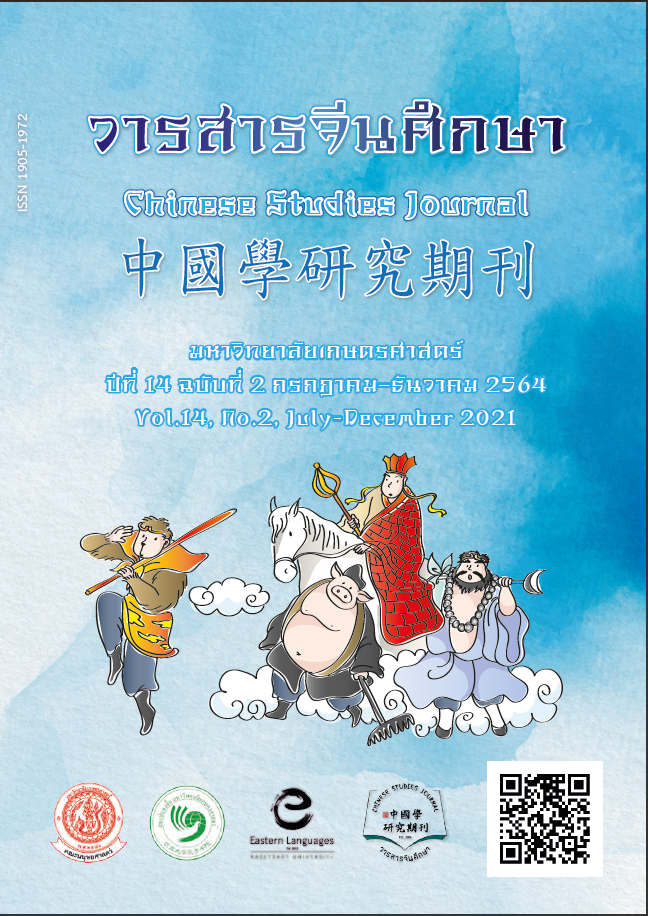A Study of Characteristics and Strategies for Translating Prohibited Words in the Chinese to Thai Subtitles of the Chinese Boys’ love series A Case Study of the Boys Love Series “Addicted”
Main Article Content
Abstract
Translating prohibited words in subtitles is an art and science. To say, not only do translators have to maintain the original meaning of the source language, reduce the cross-cultural difference between the two languages, select and use the translation which keeps the characters’ violence, rudeness, and emotion, they also have to realize the suitability for publicity. The objective of this research article is to study the characteristics and strategies for translating prohibited words in the Chinese to Thai subtitles of the Chinese boys’ love series “Addicted”, which is the Chinese boys’ love series that expressly contain prohibited words and sexual words. The researchers adapted the categorization of prohibited words by Nantawat Nedjaroen (2015) and the categorization of swear words by Orathai Chinakkhrapong (2014) and also classified the type of prohibited words additionally. Therefore, the researchers categorized the types of the prohibited words in the boys’ love into 3 specific categories: (1) profanity (2) scolding, insults, and slanders (3) words relating or intending to sexual meaning 18+. After analyzing the characteristics of translating various prohibited words with the strategies of translation by Supakanda Thongboonrod (2002) and Zarah Davoodi (2009), the researcher found that the Chinese boys’ love series “Addicted” used the strategies of translation as follows: emotional comparison (48.1%), literal translation (30%), translating simple words with prohibited words (8.1%), word-form comparison or interpretation (6.67%), word violence reduction or euphemism (4.75%) and word substitution (2.23%).
Article Details
ผลงานทางวิชาการที่ลงตีพิมพ์ในวารสารจีนศึกษา มหาวิทยาลัยเกษตรศาสตร์ เป็นลิขสิทธิ์ของผู้เขียนหรือผู้แปลผลงานนั้น หากนำลงในวารสารจีนศึกษาเป็นครั้งแรก เจ้าของผลงานสามารถนำไปตีพิมพ์ซ้ำในวารสารหรือหนังสืออื่นได้โดยมิต้องแจ้งให้ทราบล่วงหน้า แต่หากผลงานที่ได้รับพิจารณานำลงในวารสารจีนศึกษา เป็นผลงานที่เคยตีพิมพ์ที่อื่นมาก่อนเจ้าของผลงานต้องจัดการเรื่องปัญหาลิขสิทธิ์กับแหล่งพิมพ์แรกเอง หากเกิดปัญหาทางกฎหมาย ถือว่าไม่อยู่ในความรับผิดชอบของวารสารจีนศึกษา มหาวิทยาลัยเกษตรศาสตร์ ทั้งนี้ ความคิดเห็นต่างๆ ในบทความเป็นความคิดเห็นส่วนตัวของผู้เขียน ไม่เกี่ยวกับกองบรรณาธิการวารสารจีนศึกษา มหาวิทยาลัยเกษตรศาสตร์
References
กุลชาติ ศรีโพธิ์. (2548). การสื่อสารผ่านการแปลคำสบถ และคำหยาบคายในภาพยนตร์ต่างประเทศ. จุฬาลงกรณ์มหาวิทยาลัย. กรุุงเทพมหานคร.
ชนัญชิดา เถาวัลย์. (2564). การศึกษาการแปลถ้อยคำต้องห้ามในบทบรรยายใต้ภาพชุดการ์ตูนแอนิเมชันสำหรับผู้ใหญ่เรื่่อง Big Mouth จากภาษาอังกฤษเป็นภาษาไทย. วารสารภาษา ศาสนา และวัฒนธรรม, 10(1), 1-26.
เธียรชัย เอี่ยมวรเมธ (2554). พจนานุกรมจีน-ไทย ฉบับใหม่ พ.ศ. 2554. กรุงเทพฯ: บริษัทรวมสาส์น (1997) จำกัด.
นันทวัฒน์ เนตรเจริญ และสุวัฒนา เลี่ยมประวัติ. (2558). “การแปลถ้อยคำต้องห้ามที่ใช้เน้นความหมายในวรรณกรรมเรื่อง The Catcher in the Rye”. วารสารสาขามนุษยศาสตร์ สังคมศาสตร์ และศิลปะ, 8(3), 169-184.
พันศักดิ์ อัศววงศ์เกษม. (2561). เรื่องเพศกับการเซ็นเซอร์: การแปลภาษาต้องห้ามในนวนิยาย เรื่อง Fifty Shades of Grey ของ E. L. James. วารสารการแปลและการล่าม, 3(2), 90-137.
พรพรรณ กิตติดุษฎีกุล. (2561). การแปลภาษาวัยรุ่นร่วมสมัยในนวนิยายเรื่อง “สาวเจ้าปัญหา” ของเบ๊บ วอล์คเกอร์. วารสารภาษาและวัฒนธรรม, 37(2), 9-34.
พรรณี ภาระโภชน์. (2555). การแปลคำศัพท์ทางวัฒนธรรมในนวนิยายเรื่อง "Memoirs of a Geisha". วารสารภาษาและวัฒนธรรม, 31(1), 5-17.
ราชบัณฑิตยสถาน. (2545). พจนานุกรมฉบับราชบัณฑิตยสถาน พ.ศ. 2545. กรุงเทพฯ: ผู้แต่ง.
ศุภกานดา ทองบุญรอด. (2545). “กลวิธีการแปลภาษาเพศชาย”. วิทยานิพนธ์มหาบัณฑิต สาขาวิชาภาษาและวัฒนธรรมเพื่อการสื่อสารและการพัฒนา บัณฑิตวิทยาลัยมหาวิทยาลัยมหิดล.
ศิวนนท์ นิลพาณิชย. (2559). การแปลบทพูดกะเทยจากภาษาไทยเป็นภาษาอังกฤษ: กรณีศึกษาภาพยนตร์เรื่อง “สตรีเหล็ก ภาค 1” และหนังสั้นรักจริงปิ๊งเก้อ “Change: รัก...ไม่เปลี่ยน”. วารสารมนุษยศาสตร์ สังคมศาสตร์, 33(3), 67-99.
อุกฤษฏ์ ยลธรรม์ธรรม. (2560). บทแปลเรื่อง “เจ็ดปมสังหาร” ของ มาร์ลอน เจมส์ พร้อมบทวิเคราะห์ (สาร์นิพนธ์ปริญญามหาบัณฑิติ) : มหาวิทยาลัยธรรมศาสตร์, กรุุงเทพมหานคร.
อรทัย ชินอัครพงศ์. (2557). อุปลักษณ์เชิงมโนทัศน์ของคำด่าในภาษาไทย. วารสารมนุษยศาสตร์ : มหาวิทยาลัยนเรศวร, 11(2), 57-76.
Davoodi, Z. (2009). On the Translation of Taboos. Retrieved from https://www.translationdirectory.com/articles/article2052.php (5 มิถุนายน 2564)


